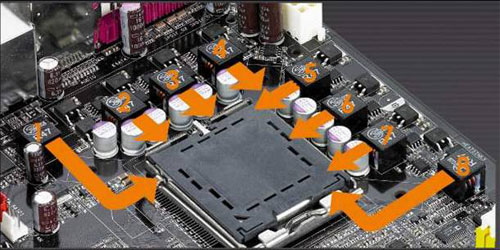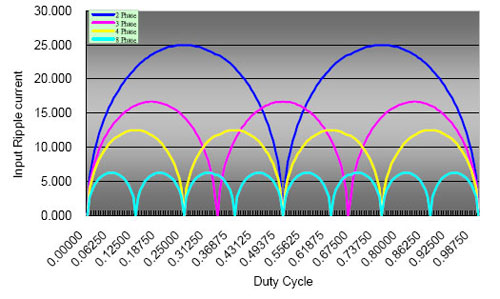Asus A8N32-SLI Deluxe: NVIDIA Dual x16 for the Athlon 64
by Wesley Fink on November 6, 2005 9:00 AM EST- Posted in
- Motherboards
8-Phase Power and Dual x16 PCIe
Two areas really stand out with the new Asus A8N32-SLI. First, this is the launch of a true dual x16 SLI board. That means that you can bridge two video cards at full x16 speed in each slot instead of the x8 speed of current SLI.
8-Phase Power
The new Asus 32-SLI boards, both the recently tested P5N32-SLI for Intel processors and this A8N32-SLI for AMD, are the first 8-phase desktop boards that we have tested. Those who have questioned whether the design is truly 8-phase will be interested in this shot with the MOSFET heatsinks removed on the Intel version. There are 8 coils and 8 banks of MOSFETS along the two sides of the CPU.
Low ripple voltage can stabilize the CPU at working voltage, but it also can increase the over-clocking margin. An Asus White Paper uses the analogy of ripple voltage being like waves in an ocean and the CPU is like a boat. It is very hard for a boat to go forward in big waves (High ripple voltage), and the big waves can even turn the boat around (Burnout of the CPU). On the other hand, it is easy for a boat to move forward in small waves (Low ripple voltage), and the boat can even go faster (Overclocking the CPU) in an ocean with small waves.
The other advantages of 8-phase are a current reduction of up to 50% compared to 4-phase, which can yield a power reduction of about 25% over 4-phase. This even applies to a reduction in power consumption in a high-end CPU. Asus claims that a CPU requiring 130W in a 4-phase design will see a 10% reduction in power consumption in an 8-phase design.
Dual x16 PCIe
While both the P5N32-SLI for Intel and this A8N32-SLI for AMD provide two full speed 16-bit slots for SLI, they use a slightly different set of chipsets to drive this feature. This AMD version uses what is basically a C51 Northbridge chip without integrated graphics for the A8N32-SLI North Bridge and an nForce4 SLI chip for the South Bridge. In this hybrid design, each bridge drives one x16 slot and a total of 40 PCIe lanes are available to the board.
The Intel processor solution from NVIDIA uses the Intel C19 for the Northbridge and the same nForce4 SLI for the South Bridge. The 2 chips communicate via a Hypertransport link just like the chips in the AMD solution.
Whatever the differences in approach, both the Intel and AMD versions provide full dual x16 PCIe slots, which can be combined into Dual x16 SLI video. There are also other potential design uses as you saw in the Gigabyte quad PCIe review, where the board could enable four x8 PCIe slots to drive up to 10 monitors.
Two areas really stand out with the new Asus A8N32-SLI. First, this is the launch of a true dual x16 SLI board. That means that you can bridge two video cards at full x16 speed in each slot instead of the x8 speed of current SLI.
8-Phase Power
The new Asus 32-SLI boards, both the recently tested P5N32-SLI for Intel processors and this A8N32-SLI for AMD, are the first 8-phase desktop boards that we have tested. Those who have questioned whether the design is truly 8-phase will be interested in this shot with the MOSFET heatsinks removed on the Intel version. There are 8 coils and 8 banks of MOSFETS along the two sides of the CPU.


| CPU Current 100A | 2-Phase | 3-Phase | 4-Phase | 8-Phase |
| Input Ripple Current (A) | 22.63 | 16.508 | 12.359 | 4.463 |
Low ripple voltage can stabilize the CPU at working voltage, but it also can increase the over-clocking margin. An Asus White Paper uses the analogy of ripple voltage being like waves in an ocean and the CPU is like a boat. It is very hard for a boat to go forward in big waves (High ripple voltage), and the big waves can even turn the boat around (Burnout of the CPU). On the other hand, it is easy for a boat to move forward in small waves (Low ripple voltage), and the boat can even go faster (Overclocking the CPU) in an ocean with small waves.
The other advantages of 8-phase are a current reduction of up to 50% compared to 4-phase, which can yield a power reduction of about 25% over 4-phase. This even applies to a reduction in power consumption in a high-end CPU. Asus claims that a CPU requiring 130W in a 4-phase design will see a 10% reduction in power consumption in an 8-phase design.

Dual x16 PCIe
While both the P5N32-SLI for Intel and this A8N32-SLI for AMD provide two full speed 16-bit slots for SLI, they use a slightly different set of chipsets to drive this feature. This AMD version uses what is basically a C51 Northbridge chip without integrated graphics for the A8N32-SLI North Bridge and an nForce4 SLI chip for the South Bridge. In this hybrid design, each bridge drives one x16 slot and a total of 40 PCIe lanes are available to the board.
The Intel processor solution from NVIDIA uses the Intel C19 for the Northbridge and the same nForce4 SLI for the South Bridge. The 2 chips communicate via a Hypertransport link just like the chips in the AMD solution.
Whatever the differences in approach, both the Intel and AMD versions provide full dual x16 PCIe slots, which can be combined into Dual x16 SLI video. There are also other potential design uses as you saw in the Gigabyte quad PCIe review, where the board could enable four x8 PCIe slots to drive up to 10 monitors.










95 Comments
View All Comments
Marlin1975 - Friday, November 4, 2005 - link
That can not be stressed enough. I don't mind paying a couple extra bucks to get a nice VIA Envy sound or even the new C-media Dolby chip. But the ac97 realtek junk needs to die.
phusg - Friday, November 4, 2005 - link
Agreed. Only it's even worse: nVidia pioneered decent on-board sound with their nForce1 chipset (not nForce2).
Concillian - Friday, November 4, 2005 - link
I definitely agree, and don't think this was mentioned in the 'Final Words'.With lack of PCI-e support from soundcards and many other add-in cards, it's important to minimize add-in cards, especially on an SLI setup where slots may be eaten up by coolers for the 2 video cards.
With the way this board is layed out, if you have 2 cards in SLI with big coolers you have 1 PCI and 1 x4 PCI-e slot left. If you're forced to populate the PCI slot with a soundcard you're done... seeing as how there are very few PCI-e cards out there.
I would also not be blaming nVidia... ASUS could implement a better audio solution if they wanted to (like DFI does with Karajan and MSI does with SBLive!), but they chose not to. To blame nVidia seemingly absolves ASUS of responsibility, and that's not right. The board is made by ASUS, not nVidia. Any blame for a poor audio implementation belongs to ASUS.
nVidia supposedly had little demand for soundstorm because motherboard manufacturers weren't ordering enough. At least that's the story that was fed to us. Giving specific manufacturer designs poor ratings because of crappy audio implementation is the way to get manufacturers to implement better solutions regardless of what their supplier gives them. Blaming their supplier gives them a cop out. Blaming ASUS gets them looking for innovative solutions and asking nVidia to supply them with better options integrated into future chipsets.
phusg - Friday, November 4, 2005 - link
Also the motherboard manufacturers complained at the high cost of the Dolby Digital Live licence (something like $5 a chipset if I remember rightly). I've always said nVidia should go have a chat with the competitors DTS. Wouldn't that be something?
DanaGoyette - Friday, November 4, 2005 - link
I've been pondering this for a while:Since the nForce4 x16 northbridge uses Hypertransport to communicate with its southbridge,
and the nForce2 southbridge uses HyperTransport to communicate with its northbridge,
Shouldn't it be possible to replace or supplement the nForce4 southbridge with the nForce2 MCP-T and use its APU? Either that, or combine it with the nForce Professional MCPe?
Even better, use the nForce2 MCP-T with the GeForce 6100/6150 northbridge for integrated audio and video!
psychobriggsy - Friday, November 4, 2005 - link
It all depends on whether the southbridge used (a standard nForce4 SLI) has a downstream HyperTransport link.I imagine it doesn't, therefore you have: [CPU]===[nF SP100]===[nF SLI]
I suppose you could connect an ULi PCIe southbridge to a couple of spare PCIe lanes for it's built in Azalia audio, and another bazillion SATA ports, IDE ports and USB ports, lol.
DanaGoyette - Friday, November 4, 2005 - link
Er, I didn't mean nForce Professional AND nf4 with the MCP-T, I meant one or the other. I wonder if it's even possible to use the NF2 southbridge like this. I believe the BIOS might take some work, but you never know until you try![CPU] - [nF Pro] - [NF2 MCP-T]
[CPU] - [SLIx16] - [NF2 MCP-T]
[CPU] - [gf6100] - [NF2 MCP-T]
yacoub - Friday, November 4, 2005 - link
This board is definitely on my list to track pricing. If this thing comes down enough I'll be getting this when I build my new system instead of the older Asus SLI-Premium I was looking at.Hopefully Asus soon releases that sweet passively-cooled 7800series card (hopefully a GT) as well. It debuted in this article: http://www.anandtech.com/tradeshows/showdoc.aspx?i...">http://www.anandtech.com/tradeshows/showdoc.aspx?i...
yacoub - Friday, November 4, 2005 - link
Can you mount an XP-90 on the processor without interfering with the heatpipes or MOSFETs around the socket?yacoub - Friday, November 4, 2005 - link
Did you guys test any of the aftermarket cooling systems like the XP90 and XP120 for clearance? That's rather important to overclockers, especially on a board like this!